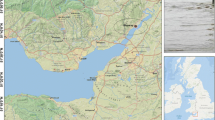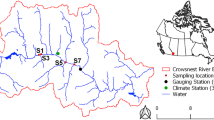Abstract
Suspended matter usually flocculates into fragile flocs that break up during sampling and analysis. Coulter counter and pipette size analysis are therefore an indication of floc strength. Grain-size distributions (after removal of organic matter) give an indication of the relative amount of grains transported as flocs (as opposed to being transported as single particles).In situ size distributions of suspended matter (flocs) in the Scheldt and Rhine estuaries and the Gironde, as well as results from the Zaire River estuary, indicated that salt flocculation does not appear to be of importance for the formation ofin situ flocs. Also there is no clear relation with particle concentration. In estuaries probably no equilibrium between floc size and concentration is reached because of the rapid variations in turbulence and bottom shear. In the Zaire estuary a decrease in turbulence in the surface water results in flocs of the same size as differential settling over a depth of more than 100 meters.
Similar content being viewed by others
References
Alldredge AL and Silver MW, 1988. Characteristics, dynamics and significance of marine snow.Progress in Oceanography 20:41–82.
Bale AJ and Morris AW, 1987. In situ measurement of particle size in estuarine waters.Estuarine Coastal and Shelf Science 24:253–263.
Coles SL and Stratham R, 1973. Observations on coral mucus “flocs” and their potential atrophic significance.Limnology and Oceanography 18:673–678.
Edzwald JK and O'Melia Ch.R, 1975. Clay distributions in recent estuarine sediments.Clay and Clay Mineral 23:39–44.
Eisma D, 1986. Flocculation and deflocculation of suspended matter in estuaries.Netherlands Journal of Sea Research 20:183–199.
Eisma D, Bernard P, Cadée GC, Ittekkot V, Kalf J, Laane R, Martin JM, Mook WG, Van Put A, and Schuhmacher T, in press. Suspended matter particle size in some Westeuropean estuaries. Parts I and II.Netherlands Journal of Sea Research 28.
Eisma D, Boon J, Groenewegen R, Ittekkot V, Kalf J, and Mook WG, 1983. Observations on macroaggregates, particle size and organic composition of suspended matter in the Ems estuary. Mitteilung geologisch-paläontologischen Institut der Universität Hamburg,55:295–314.
Eisma D, and Kalf J, 1987. Distribution, organic content and particle size of suspended matter in the North Sea.Netherlands Journal of Sea Research 21:265–285.
Eisma D, Schuhmacher T, Boekel H, van Heerwaarden J, Franken H, Laan M, Vaars A, Eygenraam F, and Kalf J, 1990. A camera and image-analysis system for in situ observation of flocs in natural waters.Netherlands Journal of Sea Research 27:43–56.
Eisma D and van Bennekom AJ, 1978. The Zaire river and estuary and the Zaire outflow in the Atlantic Ocean.Netherlands Journal of Sea Research 12:255–272.
Gibbs RJ, 1981. Floc breakage by pumps.Journal of Sedimentary Petrology 51:670–672.
Gibbs RJ, 1982. Floc stability during Coulter-counter size analysis.Journal of Sedimentary Petrology 52:657–660.
Gibbs RJ, and Konwar LN, 1982. Effect of pipetting on mineral flocs.Environmental Science and Technology 16:119–121.
Hannah SA, Cohen JM, and Robeck GG, 1967. Measurement of floc strength by particle counting.Journal AWWA 1987:843–858.
Hunter KA and Liss PS, 1982. Organic matter and surface charge of suspended particles in estuarine waters.Limnology and Oceanography 27:322–335.
Kranck K, 1981. Particulate matter grain-size characteristics and flocculation in a partially mixed estuary.Sedimentology 28:107–114.
Neihof RA and Loeb GI, 1972. The surface charge of particulate matter in seawater.Limnology and Oceanography 17:7–16.
Neihof RA and Loeb GI, 1974. Dissolved organic matter in seawater and the electric charge of immersed surfaces.Journal of Marine Research 32:5–12.
Owen MW, 1970. A detailed study of the settling velocities of an estuary mud. Hydraulic Research Station Wallingford Report INT 78. 25 pp.
Puls W, Kuehl H, and Heymann K, 1988. Settling velocity of mud flocs: results of field measurements in the Elbe and the Weser estuary. In: Dronkers J and van Leussen W (Eds.), Physical processes in estuaries. Springer-Verlag, New York. 404–424.
Ribelin BW and Collier AW, 1970. In: Livingston, RJ, (Ed.), Ecological processes in coastal and marine systems. Plenum Press, New York. 47–68.
Sholkovitz ER, 1976. Flocculation of dissolved organic and inorganic matter during the mixing of river water and seawater.Geochimica Cosmochimica Acta 40:831–845.
Author information
Authors and Affiliations
Rights and permissions
About this article
Cite this article
Eisma, D. Particle size of suspended matter in estuaries. Geo-Marine Letters 11, 147–153 (1991). https://doi.org/10.1007/BF02431001
Issue Date:
DOI: https://doi.org/10.1007/BF02431001




